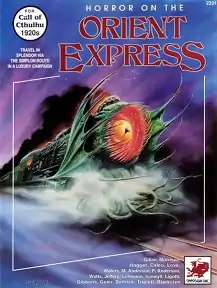Horror on the Orient Express
Horror on the Orient Express is a Horror tabletop role-playing campaign, written by Geoff Gillan, Nick Hagger, Penelope Love, Marion Anderson, Richard Watts, Christian Lehmann, Mark Morrison, Bernard Caleo, Russell Waters, Phil Anderson, Peter F. Jeffery, L. N. Isinwy-II, Thomas Ligotti, and Lynn Willis, with art by Lee Gibbons, and published by Chaosium in 1991. A second edition was published in 2014. Horror on the Orient Express is an award winning[1] campaign for Call of Cthulhu.
 Horror on the Orient Express (boxed set) published by Chaosium in 1991. Illustration by Lee Gibbons, 1983. | |
| Designer(s) | Geoff Gillan, Nick Hagger, Penelope Love, Marion Anderson, Richard Watts, Christian Lehmann, Mark Morrison, Bernard Caleo, Russell Waters, Phil Anderson, Peter F. Jeffery, L. N. Isinwy-II, Thomas Ligotti, and Lynn Willis |
|---|---|
| Publisher(s) | Chaosium |
| Publication date | 1991 1st edition 2014 2nd edition |
| Genre(s) | Horror |
| System(s) | Basic Role-Playing |
Plot summary
Horror on the Orient Express is a campaign where, starting in London and continuing along the route of the Orient Express, the Investigators must search for the pieces of an artifact called the Sedefkar Simulacrum.[2][3] A cult called the Brothers of the Skin tries to stop them.[4]
The game notes indicate that this is a very deadly adventure where 70% of the Investigators will die; this very high mortality rate was confirmed by reviewers.[4][3]
Publication history
In the 2014 book Designers & Dragons, Shannon Appelcline discussed early 1990s publications for Call of Cthulhu, and noted that "Horror on the Orient Express (1991), another classic mega-adventure, also appeared during these years."[5]:269
The game was designed by Geoff Gillan, Nick Hagger, Penelope Love, Marion Anderson, Richard Watts, Christian Lehmann, Mark Morrison, Bernard Caleo, Russell Waters, Phil Anderson, Peter F. Jeffery, L. N. Isinwy-II, Thomas Ligotti, and Lynn Willis. Interior art was by Earl Geier, Laurie Deitrick, Carol Triplett, and Gustaf Bjorksten, and cover art was by Lee Gibbons. It was published as a boxed set that contained:
- four campaign books totalling 205 pages
- 32-page "Strangers on the Train" booklet
- 16 pages of player hand-outs
- 17” × 27” map sheet
- four 11” × 17” cardboard cut-out train car plans
- 11” × 17” cardboard cut-out of Sedefkar Simulacrum
- 11” × 17” cut-out of Scroll of the Head
- four passport forms
- two luggage stickers
- 11” × 15” Chaosium Inc. poster[4]
Reception
In the Fall 1991 edition of The Unspeakable Oath (Issue #4), John Tynes called the campaign "one of the most intriguing releases Chaosium has ever put out." He was impressed by the quality of the player handouts, calling them "luxurious", especially "the passports, printed on linen paper with graciously embossed seals." However, although Tynes thought the first few scenarios were quite good, he did not like the middle section of the game where he felt "things rocket downhill as the campaign goes from okay, to fair, to middling, then begins to suck." Tynes felt that the middle third of the game railroaded the players by leading them along one storyline — "pop the investigators into one end of the tube and pop them out the other." But Tynes was impressed with the final third of the game, calling it "just excellent. Lots of thrills and nasty stuff, some good investigative work, and a series of false climaxzes that will leave players wheezing and investigators dead." Tynes concluded by saying that the game "is really for experienced Keepers only." He rated the final third of the campaign 8 out of 10, but overall gave the game a poor rating of only 5 out of 10 due to the middle third of the game.[3]
In the September 1992 edition of Dragon (Issue #185), Rick Swan was impressed, calling this campaign "a start-to-finish knockout, a dazzling and intoxicating Call of Cthulhu campaign with the scope and richness of an epic novel. Thanks to the strong narrative and skillful pacing, the suspense never lags and the surprises never stop coming, a remarkable achievement for an adventure spanning more than 200 pages." The only negative note Swan made was about the game box, which he called "a flimsy single-piece affair virtually guaranteed to disintegrate." But he gave everything else the thumbs-up. "The components themselves are superb [...] The books are well-organized and loaded with troubleshooting tips, making the complex adventure relatively easy to run [...] The story carries the players along on a series of cascading shocks, each more jaw-dropping than the one before." He concluded with a strong recommendation, saying, "Many RPG products aspire to greatness, but few actually achieve it. Horror on the Orient Express qualifies as a work of art. The provocative cast of characters, colorful settings, and heart-stopping encounters add up to a gaming experience that few players will soon forget. I envy anyone who’s about to get started. I wish I could do it again."[4]
Awards
At the 1992 Origins Award, Horror on the Orient Express won two awards, for "Best Roleplaying Adventure of 1991", and "Best Graphic Presentation of a Roleplaying Game, Adventure, or Supplement of 1991".[1]
Reviews
- White Wolf #30 (Feb., 1992)
- Casus Belli (v4, Issue 12 - Nov/Dec 2014)[6]
References
- "Origins Award Winners (1991)". Academy of Adventure Gaming Arts & Design. Archived from the original on 2007-11-05. Retrieved 2007-11-03.
- https://index.rpg.net/display-entry.phtml?mainid=3101
- Tynes, John (Fall 1991). "The Eye of Light and Darkness". The Unspeakable Oath. Pagan Publishing (4): 26–36.
- Swan, Rick (September 1992). "Roleplaying Reviews". Dragon. TSR, Inc. (185): 66–67.
- Shannon Appelcline (2014). Designers & Dragons: The '70s. Evil Hat Productions. ISBN 978-1-61317-075-5.
- https://rpggeek.com/rpgissuearticle/162501/terreur-sur-lorient-express